Anti Malarial Drugs Market Size
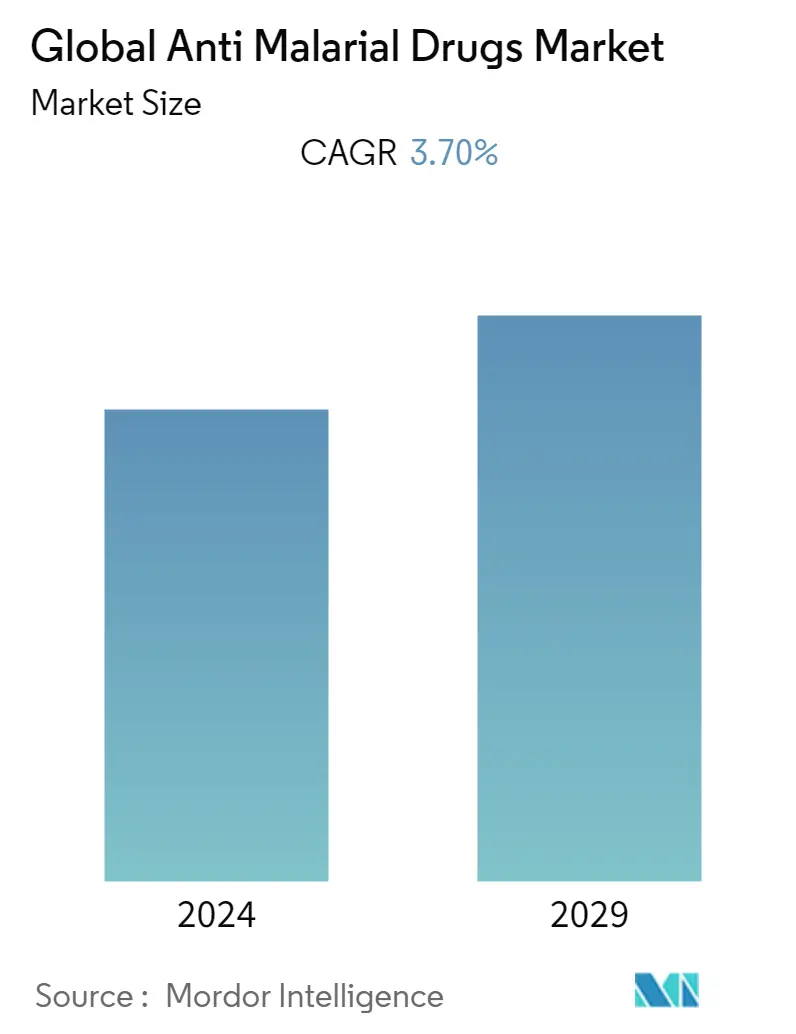
| Study Period | 2019 - 2029 |
| Base Year For Estimation | 2023 |
| Forecast Data Period | 2024 - 2029 |
| CAGR | 3.70 % |
| Fastest Growing Market | Asia Pacific |
| Largest Market | Middle-East and Africa |
Major Players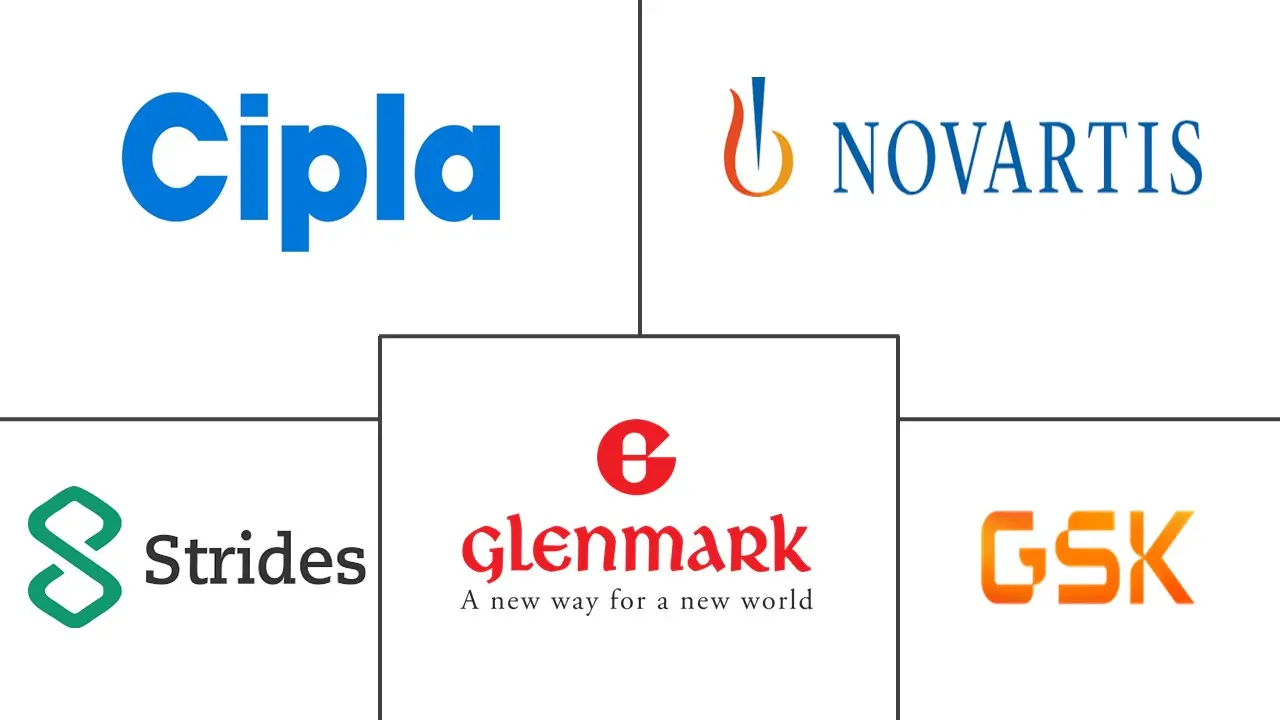
*Disclaimer: Major Players sorted in no particular order |
Anti Malarial Drugs Market Analysis
The Anti Malarial Drugs market is expected to register a CAGR of 3.7% over the forecast period (2022-2027).
COVID-19 has dramatically impacted the anti-malarial drugs market due to the rise in the adoption of anti-malarial drugs such as chloroquine and hydroxychloroquine in COVID-19 patients. For instance, according to the study titled 'Chloroquine and hydroxychloroquine in the treatment of COVID-19: the never-ending story' published in January 2021, the anti-malarial medications chloroquine (CQ) and hydroxychloroquine (HCQ) have been proposed as potential treatments for COVID-19 and as promising therapeutics against the novel coronavirus SARS-CoV-2. Therefore the repurposing of anti-malarial drugs for the treatment of COVID-19 has led to a dramatic rise in the adoption of anti-malarial therapies, driving the market growth during the pandemic.
The factors driving the growth of anti-malarial drugs include the high prevalence of malaria in developing and underdeveloped countries, increasing awareness initiatives undertaken by government, increasing research for new drugs and new combinations therapies, among others.
According to the 'World Malaria Report 2021' by World Health Organization (WHO), there were an estimated 228 million cases and nearly 602,000 malaria-related deaths in 2020. Hence, the high prevalence of malaria will lead to rise in adoption of anti malarial therapies, driving the growth of this market.
The other factors includes the increase in awareness initiatives by governments and research for new anti-malarial drugs and therapies are also helping this market grow. For instance, in December 2021, the United States Food and Drug Administration has approved orphan drug designation to the Cadila Healthcare's antimalarial drug ZY19489 (MMV253) currently in development together with Medicines for Malaria Venture (MMV). Furthermore, in March 2021, according to the news, Francis Crick Institute and the Latvian Institute of Organic Synthesis researchers have designed a drug-like compound which effectively blocks a critical step in the malaria parasite life cycle and are working to develop this compound into a potential first of its kind malaria treatment. The rise in research in the development of anti malarial drugs will lead to the entry of novel molecules for anti malarial therapy in the market, thereby lead to rise in adoption, driving the market growth.
Furthermore, in June 2021, according to the news, the government of Malawi launched 'Zero Malaria Starts with Me' campaign to end malaria by the year 2030, which is the main cause of death in Malawi and 15% of hospital admissions in Malawi are due to a parasitic ailment that is carried by mosquitoes.
However, side-effects of anti-malarial drugs and presence of counterfeit and substandard drugs are restraining the overall growth of this market.
Anti Malarial Drugs Market Trends
This section covers the major market trends shaping the Anti Malarial Drugs Market according to our research experts:
Artemisinin Compounds Segment is Expected to Register High Growth During the Forecast Period
The artemisinin-based compounds (ACTs) and the combination therapies (ACTs) for found to be effective treatments used for the treatment of uncomplicated malaria caused by the P. falciparum parasite. By combining 2 active ingredients with different mechanisms of action, ACTs are the most effective antimalarial medicines currently available on the market.
Rising initiatives by the key market players for the development of next-generation antimalarials to combat the threat of artemisinin resistance will lead to increased adoption of artemisinin-based drugs, driving the market growth. For instance, in May 2021. Novartis continues to invest in research and development for next-generation antimalarials to combat the threat of artemisinin resistance. Furthermore, according to the same source, the most lethal form of malaria, P. falciparum, which accounts for more than 99% of cases in Africa and 50% of cases in Asia, is treated with standard of care ACTs. Such initiatives from the key market players will lead to increased adoption of ACTs driving this segment's growth.
Furthermore, according to the study titled 'Artemisinin-based combination therapy for uncomplicated Plasmodium falciparum malaria in Mali: a systematic review and meta-analysis' published in August 2021, Artemisinin-based combination therapy (ACT) was deployed as an alternative to chloroquine and is considered the most efficacious treatment currently available for uncomplicated falciparum malaria. It was found that, ACT remains highly efficacious in treating uncomplicated falciparum malaria in Mali. Such successful results will lead to increased adoption of artemisinin based therapies in African nations driving this segment growth.
Therefore, owing to the above mentioned factors, the artemisinin based therapies is expected to show a significant growth over the forecast period.
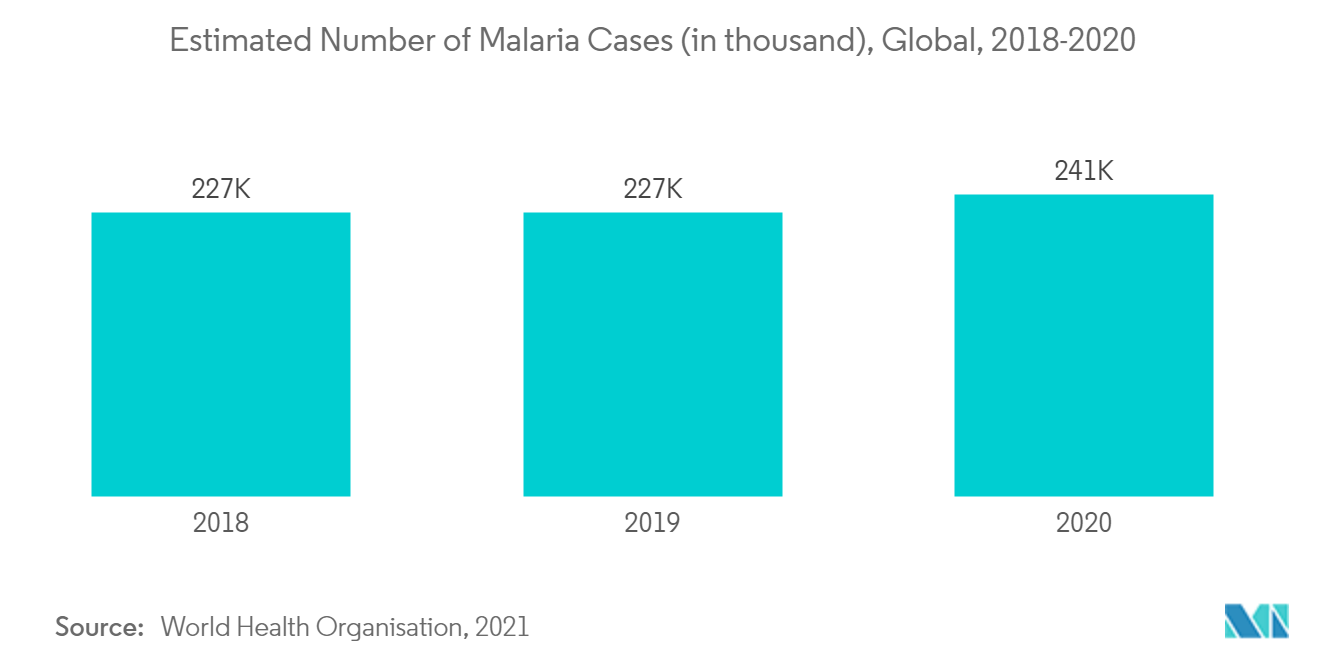
Middle East and Africa Holds a Significant Share of the Market Growth During the Forecast Period
The Middle East and Africa has been accounted for the major market share and are expected to continue this trend, owing to the rapid surge in the prevalence of malaria in the region. According to the World Health Organization (WHO) report 2021, there were an estimated 241 million cases of malaria worldwide in 2020, among them, the WHO African Region carried a significant share of the global malaria burden of 228 million cases. Therefore the Middle East and Africa region are expected to have one of the largest shares in the total anti-malarial drugs market.
Furthermore, in July 2022, Mosquirix, a vaccine developed by GlaxoSmithKline (GSK) is said to be the world's first anti-malarial vaccine launched in three African countries namely Ghana, Kenya, and Malawi under the Gavi vaccine project with the support of the Gates Foundation. Such initiatives in the African region for the prevention of malaria will lead to increased adoption of anti-malarial therapies in this region, driving market growth.
In addition, rising initiatives from the local African players for the manufacture of anti-malarial drugs and approvals from the international regulatory authorities will lead to higher adoption of these drugs in this region, driving the market growth. For instance, in August 2022, the World Health Organization has approved Kenyan producer Universal Corporation Ltd (UCL) to support regional efforts to eradicate malaria by producing high-quality sulfadoxine-pyrimethamine locally (SP). Such initiatives will lead to rise in local production of anti malarial therapies, thereby lead to rise in sales, driving the market growth in this region.
Therefore, owing to the fastest growth due to the increase in awareness regarding the use of antimalarial drugs for early diagnosis of the infection, the market is expected to show a significant growth.
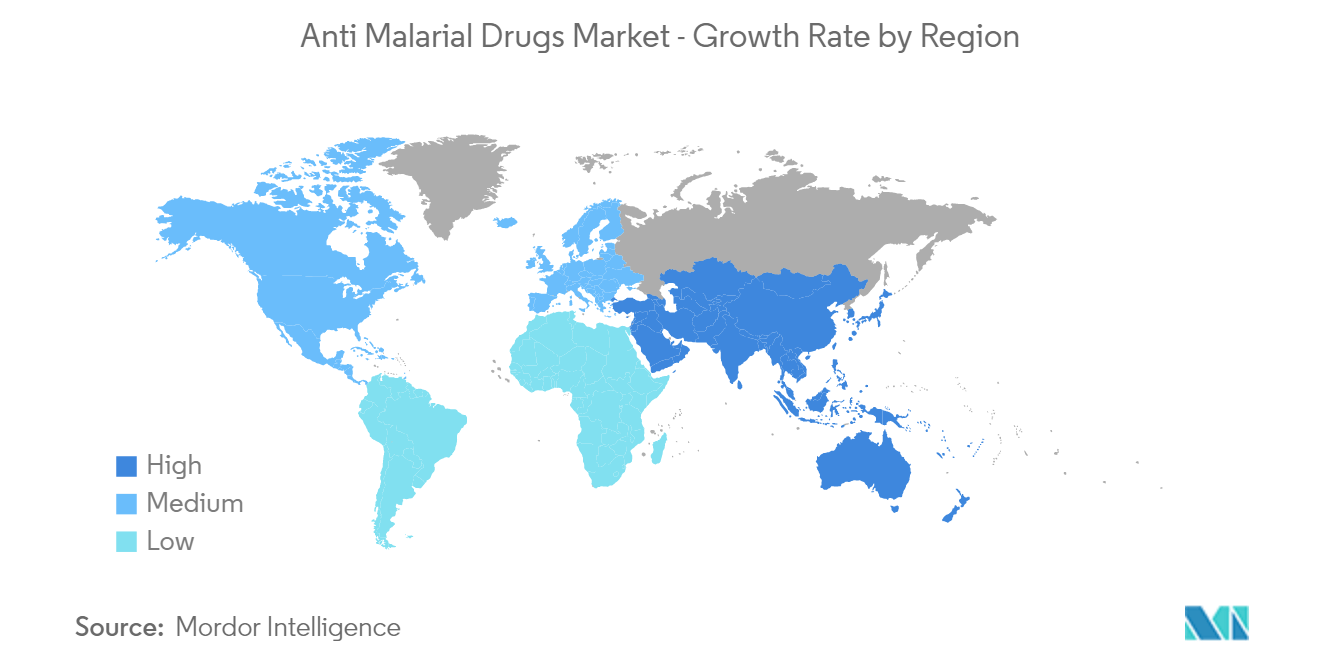
Anti Malarial Drugs Industry Overview
The majority of the anti-malarial drug is being manufactured by the global key players. Market leaders with more funds for research and better distribution system have established their position in the market. These global players are mostly based in developed countries like the United States, the United Kingdom, France, Germany, and Japan. Asia-pacific is also witnessing the emergence of some small players which has helped the market growth and increased its competitiveness. Some of the major players in the market include, Cipla, GlaxoSmithKline PLC, Novartis AG, Strides Pharma Science Limited, Glenmark Pharmaceuticals, Bayer AG, Alvizia Healthcare, among others.
Anti Malarial Drugs Market Leaders
-
Cipla
-
Novartis AG
-
Strides Pharma Science Limited
-
Glenmark Pharmaceuticals
-
GlaxoSmithKline PLC
*Disclaimer: Major Players sorted in no particular order
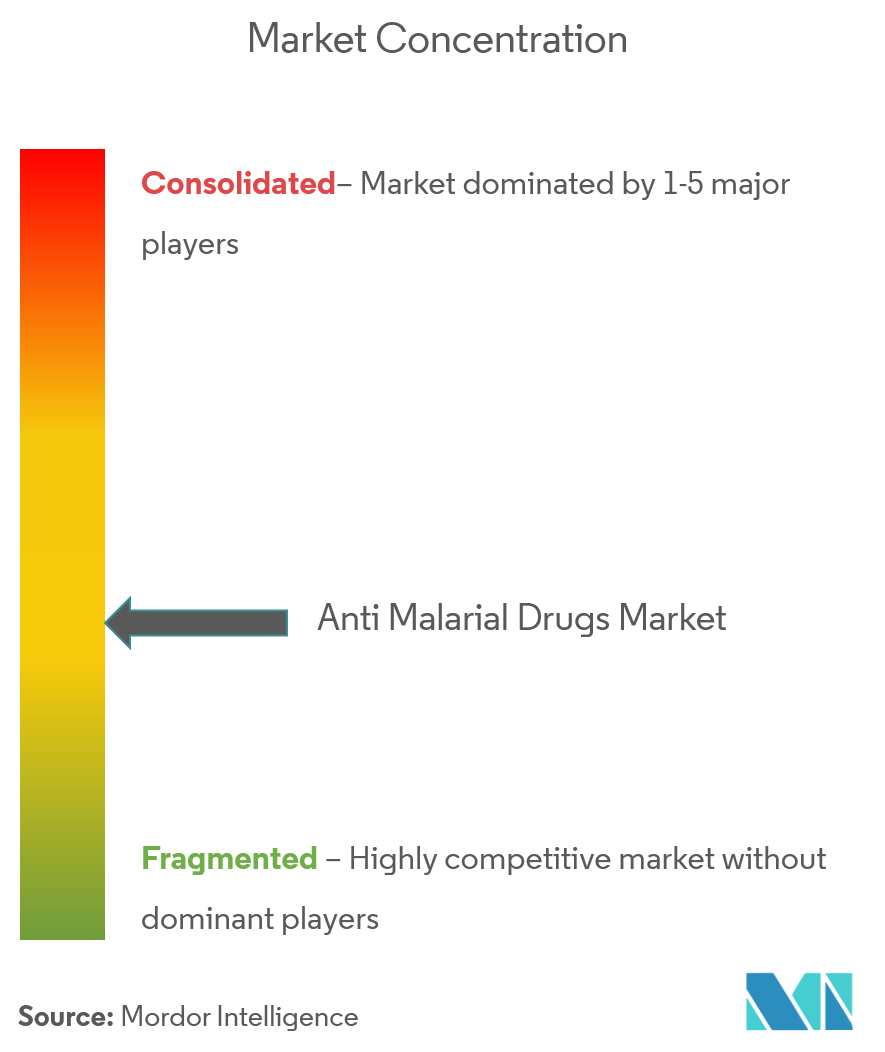
Anti Malarial Drugs Market News
- In August 2022, the British Heart Foundation planned to fund the University of Surrey to study on the implications of anti-malaria medicines on cardiac rhythm. It is to understand how drugs used to treat malaria impact the human heart.
- In March 2022, tafenoquine a new drug that can cure a certain type of malaria was approved in Australia by Medicines for Malaria Venture (MMV), which helped develop the drug with GlaxoSmithKline (GSK) for kids and teens. The drug is used in combination with the traditional malaria drug chloroquine.
Anti Malarial Drugs Market Report - Table of Contents
1. INTRODUCTION
- 1.1 Study Deliverables
- 1.2 Study Assumptions
- 1.3 Scope of the Study
2. RESEARCH METHODOLOGY
3. EXECUTIVE SUMMARY
4. MARKET DYNAMICS
- 4.1 Market Overview
-
4.2 Market Drivers
- 4.2.1 High Prevalence of Malaria in Developing and Under Developed Countries
- 4.2.2 Increasing Awareness Initiatives Undertaken by Government
- 4.2.3 Increasing Research for New Drugs and New Combinations Therapies
-
4.3 Market Restraints
- 4.3.1 Side Effects of Anti-malaria Drugs
- 4.3.2 Presence of Counterfeit and Substandard Antimalarial Drugs
-
4.4 Porter's Five Force Analysis
- 4.4.1 Threat of New Entrants
- 4.4.2 Bargaining Power of Buyers/Consumers
- 4.4.3 Bargaining Power of Suppliers
- 4.4.4 Threat of Substitute Products
- 4.4.5 Intensity of Competitive Rivalry
5. MARKET SEGMENTATION (Market Size by Value - USD million)
-
5.1 By Drug Class
- 5.1.1 Aryl aminoalcohol compounds
- 5.1.2 Antifolate compounds
- 5.1.3 Artemisinin compounds
- 5.1.4 Other Drug Types
-
5.2 By Malaria Type
- 5.2.1 Plasmodium Falciparum
- 5.2.2 Plasmodium Vivax
- 5.2.3 Plasmodium Malariae
- 5.2.4 Plasmodium Ovale
-
5.3 By Mechanism of Action
- 5.3.1 Treatment for Malaria
- 5.3.2 Prevention from Malaria
-
5.4 Geography
- 5.4.1 North America
- 5.4.1.1 United States
- 5.4.1.2 Canada
- 5.4.1.3 Mexico
- 5.4.2 Europe
- 5.4.2.1 Germany
- 5.4.2.2 United Kingdom
- 5.4.2.3 France
- 5.4.2.4 Italy
- 5.4.2.5 Spain
- 5.4.2.6 Rest of Europe
- 5.4.3 Asia Pacific
- 5.4.3.1 China
- 5.4.3.2 Japan
- 5.4.3.3 India
- 5.4.3.4 Australia
- 5.4.3.5 South Korea
- 5.4.3.6 Rest of Asia-Pacific
- 5.4.4 Middle East and Africa
- 5.4.4.1 GCC
- 5.4.4.2 South Africa
- 5.4.4.3 Rest of Middle East and Africa
- 5.4.5 South America
- 5.4.5.1 Brazil
- 5.4.5.2 Argentina
- 5.4.5.3 Rest of South America
6. COMPETITIVE LANDSCAPE
-
6.1 Company Profiles
- 6.1.1 Cadila Healthcare
- 6.1.2 Cipla Limited
- 6.1.3 GlaxoSmithKline Plc
- 6.1.4 Novartis AG
- 6.1.5 Alvizia Healthcare
- 6.1.6 Bayer AG
- 6.1.7 Lincoln Pharmaceuticals
- 6.1.8 Strides Pharma Science Limited
- 6.1.9 Glenmark Pharmaceuticals
- 6.1.10 Alliance Pharma PLC
- *List Not Exhaustive
7. MARKET OPPORTUNITIES AND FUTURE TRENDS
** Subject To AvailablityAnti Malarial Drugs Industry Segmentation
As per the scope of the report, antimalarial drugs are drugs that are designed to treat malaria in individuals or prevent infection in individuals who have no immunity to the infection. Malaria is a disease caused due to the parasite known as Plasmodium, which belongs to the organism group Protozoa. Generally, malaria is treated by single drug therapy as first-line therapy, and sometimes the combination drug therapy is for the second line of infection. Anti-malarial drugs are available on the market in the form of tablets, injectables, and capsules. The Anti Malarial Drugs Market is Segmented by Drug Class (Aryl amino alcohol compounds, Antifolate compounds, Artemisinin compounds, and Other Drug Types), Malaria Type ( Plasmodium Falciparum, Plasmodium Vivax, Plasmodium Malariae, Plasmodium Ovale) Mechanism of Action (Treatment for Malaria, Prevention from Malaria)and Geography (North America, Europe, Asia-Pacific, Middle East and Africa, and South America). The market report also covers the estimated market sizes and trends for 17 different countries across major regions, globally. The report offers the value (in USD million) for the above segments.
| By Drug Class | Aryl aminoalcohol compounds | |
| Antifolate compounds | ||
| Artemisinin compounds | ||
| Other Drug Types | ||
| By Malaria Type | Plasmodium Falciparum | |
| Plasmodium Vivax | ||
| Plasmodium Malariae | ||
| Plasmodium Ovale | ||
| By Mechanism of Action | Treatment for Malaria | |
| Prevention from Malaria | ||
| Geography | North America | United States |
| Canada | ||
| Mexico | ||
| Geography | Europe | Germany |
| United Kingdom | ||
| France | ||
| Italy | ||
| Spain | ||
| Rest of Europe | ||
| Geography | Asia Pacific | China |
| Japan | ||
| India | ||
| Australia | ||
| South Korea | ||
| Rest of Asia-Pacific | ||
| Geography | Middle East and Africa | GCC |
| South Africa | ||
| Rest of Middle East and Africa | ||
| Geography | South America | Brazil |
| Argentina | ||
| Rest of South America |
Anti Malarial Drugs Market Research FAQs
What is the current Global Anti Malarial Drugs Market size?
The Global Anti Malarial Drugs Market is projected to register a CAGR of 3.70% during the forecast period (2024-2029)
Who are the key players in Global Anti Malarial Drugs Market?
Cipla, Novartis AG, Strides Pharma Science Limited, Glenmark Pharmaceuticals and GlaxoSmithKline PLC are the major companies operating in the Global Anti Malarial Drugs Market.
Which is the fastest growing region in Global Anti Malarial Drugs Market?
Asia Pacific is estimated to grow at the highest CAGR over the forecast period (2024-2029).
Which region has the biggest share in Global Anti Malarial Drugs Market?
In 2024, the Middle-East and Africa accounts for the largest market share in Global Anti Malarial Drugs Market.
What years does this Global Anti Malarial Drugs Market cover?
The report covers the Global Anti Malarial Drugs Market historical market size for years: 2019, 2020, 2021, 2022 and 2023. The report also forecasts the Global Anti Malarial Drugs Market size for years: 2024, 2025, 2026, 2027, 2028 and 2029.
Anti Malarial Drugs Industry Report
Statistics for the 2024 Anti Malarial Drugs market share, size and revenue growth rate, created by Mordor Intelligence™ Industry Reports. Anti Malarial Drugs analysis includes a market forecast outlook 2029 and historical overview. Get a sample of this industry analysis as a free report PDF download.



